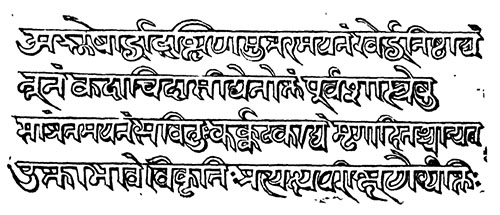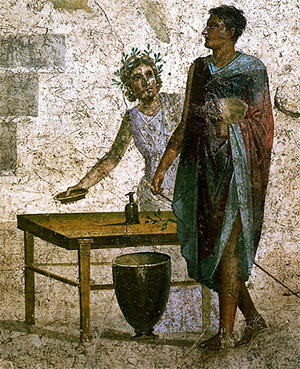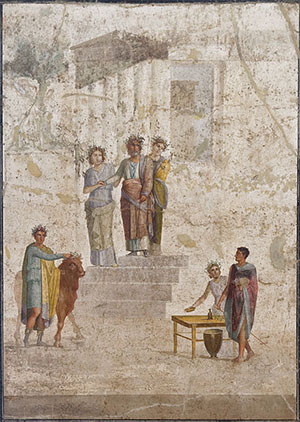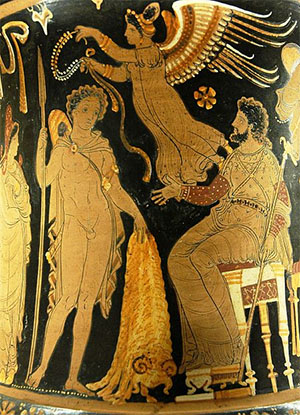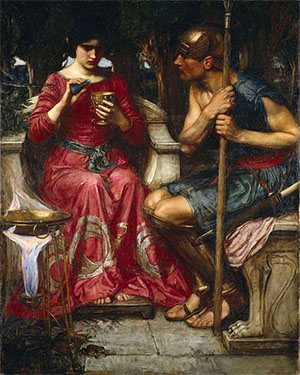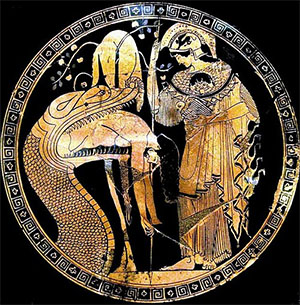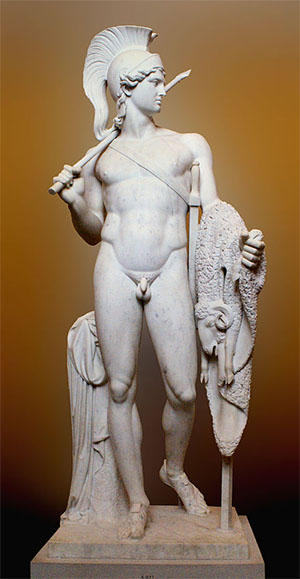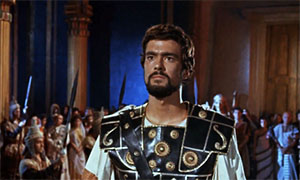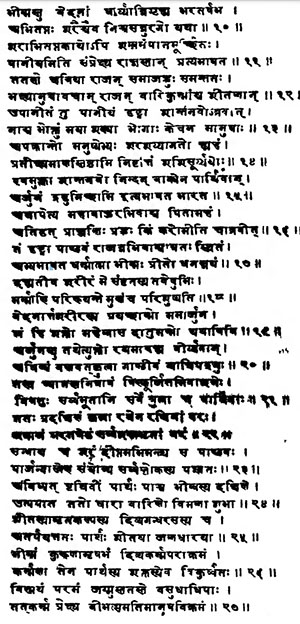by S.W. Jamison and M. Witzel
1992
Only one version of the Rigveda is known to have survived into the modern era. Several different versions of the Sama Veda and the Atharva Veda are known, and many different versions of the Yajur Veda have been found in different parts of South Asia....
The Rigveda Samhita is the oldest extant Indic text. It is a collection of 1,028 Vedic Sanskrit hymns and 10,600 verses in all, organized into ten books (Sanskrit: mandalas). The hymns are dedicated to Rigvedic deities....
The Rigveda is structured based on clear principles. The Veda begins with a small book addressed to Agni, Indra, Soma and other gods, all arranged according to decreasing total number of hymns in each deity collection; for each deity series, the hymns progress from longer to shorter ones, but the number of hymns per book increases. Finally, the meter too is systematically arranged from jagati and tristubh to anustubh and gayatri as the text progresses.
The rituals became increasingly complex over time, and the king's association with them strengthened both the position of the Brahmans and the kings. The Rajasuya rituals, performed with the coronation of a king, "set in motion [...] cyclical regenerations of the universe." In terms of substance, the nature of hymns shift from praise of deities in early books to Nasadiya Sukta with questions such as, "what is the origin of the universe?, do even gods know the answer?", the virtue of Dāna (charity) in society, and other metaphysical issues in its hymns.…
The Samaveda Samhita consists of 1549 stanzas, taken almost entirely (except for 75 mantras) from the Rigveda….Just as in the Rigveda, the early sections of Samaveda typically begin with hymns to Agni and Indra but shift to the abstract. Their meters shift also in a descending order….In the Samaveda, some of the Rigvedic verses are repeated….
The Yajurveda Samhita consists of prose mantras. It is a compilation of ritual offering formulas that were said by a priest while an individual performed ritual actions such as those before the yajna fire.… The earliest and most ancient layer of Yajurveda samhita includes about 1,875 verses, that are distinct yet borrow and build upon the foundation of verses in Rigveda. Unlike the Samaveda which is almost entirely based on Rigveda mantras and structured as songs, the Yajurveda samhitas are in prose…
The Atharvaveda was not considered as a Veda in the Vedic era... It was compiled last… The Atharvaveda is sometimes called the "Veda of magical formulas"... The Samhita layer of the text likely represents a developing 2nd millennium BCE tradition of magico-religious rites to address superstitious anxiety, spells to remove maladies believed to be caused by demons, and herbs- and nature-derived potions as medicine.
-- Vedas, by Wikipedia
Let us begin with the key to the whole system, the four Vedas: Rg Veda, Såma Veda, Yajur Veda, and Atharva Veda.
The oldest and most important in Vedic ritualism, as to later Indian religion, is the Rg Veda (hereafter also RV). This is a collection (Samhita) of rcs 'verses', forming hymns to be recited during ritual, praising various divinities. They were composed by a number of bards or bardic families, over a period of several hundred years, at the very least, as linguistic and stylistic evidence shows.8 [Possible between c. 1900 BC. and c. 1100 BCE, see above, n.1. This time frame includes only the period of possible immigration and settlement in Northern and North-West India; parts of the RV may have been composed already in Afghanistan (on the *Sarasvatī = Avest. Haraxaiti, etc.).] The ritual, as it appears in these hymns, is earlier and less developed than the "classical" one of the later texts, such as the Yajurveda Mantras and all of the Brahmanas. The Rg Veda has come down to us basically in only one9 [The other two about which we know something more than just their names are the Båskala and the Måndukeya schools, see Scheftelowitz, 1906.] extremely well preserved school, that of Śåkalya, who analyzed the traditional text towards the end of the Brahmana period, apparently in Eastern India (Videha, N. Bihar). His grammatical analysis, in form of a text without any euphonic combinations (sandhi) has been transmitted as the RV-Padapåtha.10 [Edited in Max Müller's RV (1849-74), and also several times in India as separate volumes.]
The standard editions of the Rg Veda are that of Max Müller 1849-1874, incorporating Sayana's medieval commentary (14th cent.),11 [Cf. now also the earlier commentaries of the RV, ed. Vishva Bandhu 1963-66.] and the more compact one of T. Aufrecht 1877. The standard current translation is that of K. F. Geldner 1951 (written already in the Twenties), into German, which supersedes earlier ones such as that of H. Grassmann 1876-77. There is also an almost complete French translation by L. Renou 1955-69, and the first volume of a Russian translation by T. Ya. Elizarenkova has recently appeared (1989). Unfortunately there is no complete modern English translation, though there are unsatisfactory and outmoded ones by H. H. Wilson (1888) which largely depends on the medieval commentary of Sayana, and by R. T. H. Griffith (1889-92). There are also useful translations of selected hymns, such as that of W. D. O'Flaherty 1981a and Maurer 1986 which includes much of the preceding scholarship. An up-to-date, philologically sound translation of the entire text, incorporating the grammatical and semantic progress that has been made in recent decades, would be extremely welcome.
Other important tools for Rgvedic researches include the invaluable (if somewhat out of date) Wörterbuch of H. Grassmann 1872-75, which lists all the occurrences of all but the most common words in the RV, with definitions, grammatical identification, and contextual information; the Prolegomena and the Noten of H. Oldenberg (1888 and 1909, 1912 respectively), one of the leading Western Indologists, E.V. Arnold's treatise on Vedic meter (1905), one of the first attempts to develop an internal chronology of the text, and also several of Bloomfield's reference works (Concordance, Repetitions, Variants, see below).
The Atharva Veda (AV) stands a little apart from the other three Vedas, as it does not treat the śrauta rituals, but contains magical (black and white) and healing spells, as well as two more large sections containing speculative hymns and materials dealing with some important domestic rituals such as marriage and death, with the vråtya (s. below), and with royal power.
There are two extant recensions of the AV, differing considerably from each other. Currently the more usable one is that ordinarily known as the Śaunaka recension (AVŚ, ŚS). The standard edition is that of Roth and Whitney (1856, corrected repr. Lindenau 1924). For certain sections, however, the Bombay edition by Shankar Påndurang Pandit (1895-98) or the recent amalgamated edition by Vishva Bandhu (1960-64) has to be compared, notably in book 19-20. A nearly12 [It lacks only book 20 which almost completely has been taken over from the RV. Griffith 1895-96, however, includes a translation of this book and its difficult Kuntåpa hymns as well.] complete English translation of this text exists by W. D. Whitney (1905), as well as a partial translation by M. Bloomfield (1897) that remains valuable, and a popular one by Griffith (1895-96). Whitney (1881) also compiled a complete word list, arranged grammatically, but it lacks the semantic and contextual information given by Grassmann's Wörterbuch for the RV.
The other, the Paippalåda recension (AVP, PS), was until recently known only in a very corrupt manuscript from Kashmir, which was heroically, though not too successfully edited by L. C. Barret, in a series of articles (1905-1940), save for one book done by F. Edgerton (1914). On this basis, Raghu Vira (1936-41) published the text from Lahore as well. The discovery of a much better version preserved in Orissa will now allow the Paippalåda version to take its proper place in the Vedic canon. However, only books 1-4 have been edited (D.M. Bhattacharyya 1964, D. Bhattacharya 1970). The editing and publication of the AVP based on both versions is an eagerly awaited event in Vedic studies. For preliminary studies on the history of the school, the archetype of all PS manuscripts, and on the oral tradition of the Orissa Paippalådins, see Witzel, 1985a,b; on editing problems see Hoffmann 1968a and 1979; for the relationship between PS and AVŚ, see Insler, forthc.
The Såma Veda (SV) is the collection of chants, referred to as såmans or 'melodies'. To each melody a variety of different verses can be sung; these verses are almost entirely extracted from the Rg Veda. The standard edition of the SV is that of Benfey 1848 of the Kauthuma (and Rååyanīya) recension; see also Caland's 1907 edition of the Jaiminīya recension, which to some extent differs from the Kauthuma version in order and in content (cf. Parpola 1973). Because of its dependence on the RV, -- only 75 of its Mantras are not found in the RV -- an independent translation of this text is not particularly crucial. Nonetheless, several exist, e.g. that of Griffith 1893.
The Yajur Veda is a complex entity, consisting of several partly parallel texts, most of which mix mantras (i.e. veda-text-type) with prose commentary (brahmana-text-type). It is divided into two branches: the Black (Krsna) YV (BYV) and the White (Śukla) YV (the WYV). It is the Black YV that contains the mixture of text types; the White YV contains only mantras, with its Brahmana separate. Yet it is generally considered -- see e.g. Caland, 1931b, pp. 132-133, cf. 1990, p.XIV) -- that this separation is secondary, that the mantras of the WYV were abstracted from a text that would have looked more like the BYV.
The White Yajur Veda, or Våjasaneyi Samhita (VS), has two very similar recensions, the Mådhyamdina and the Kåva (VSK). The standard edition is that of A. Weber (1852), which includes the variants of VSK. A separate edition of the VSK has been prepared by D. Satavalekar 1983 and a new edition is in progress, prepared by the indefatigable B. R. Sharma (1988-). There is a rather unsatisfactory English translation by Griffith (1899). Its massive and important Brahmana is the Śatapatha Brahmana (ŚB), the 'Brahmana of the Hundred Paths' (after the number of its 'lessons'), also with two similar recensions, likewise Madhyamdina and Kåva (ŚBM and ŚBK), whose mutual relationship is rather complicated (Caland, 1926, pp. 103-108, 1990 p. XIV). The one ordinarily referred to is the Madhyamdina, edited by A. Weber (1855) and translated into English by Eggeling (1882-1900). The Kåva recension was edited by Caland and Raghu Vira (1926-1939). There is no translation of the ŚBK, but it differs little in content and phraseology from ŚBM.
The Black YV is more complex. It exists in three major versions, parallel in great part, but often differing from each other in both phraseology and points of doctrine: the Taittirīya Samhita (TS), the Maitråyaī Samhita (MS), and the Kåthaka Samhita (KS), the latter two often agreeing with each other against the (obviously younger) TS. (There is also a fragmentary, and, as based on a very narrow tradition, somewhat corrupt fourth version, the Kapisthala Samhita (KpS), very close to the KS.) The standard edition of the TS is Weber's (1871-2), of the MS von Schroeder's (1881-86), as also of the KS (1900-1910), while Raghu Vira edited the fragments of the KpS (1932). Mittwede's useful collections of suggested emendations to the MS (1986) and KS (1989) are important tools in understanding these sometimes corrupt texts, which are based (unlike TS which still is widely recited in South India) only on the traditions of Gujarat/N. Maharashtra and Kashmir. All these texts must have been preceded by an even earlier stage of brahmana style discussion, see Hoffmann 1969, apparently that of the lost Caraka school, cf. Witzel 1982, forthc. b.
Only the TS has been translated (into English, by Keith 1914).13 [Not always reliably, however; see the review by Caland 1924.] Since MS and KS are generally fuller and more archaic in appearance than TS, translations of these two texts are badly needed. The prose of the brahmana portion of these texts is the oldest expository prose in Sanskrit, and its treatment of the ritual and narration of myths therefore extremely archaic.
Though the prose portions of the Taittirīya Samhita serve as its primary brahmana, there also exists a Taittirīya Brahmana (TB) with additional commentary (and mantras), unfortunately an inferior text with no standard edition. There are the editions prepared at Calcutta (R. L. Mitra 1859), Ānandåśrama (V.Ś. Godbole et al. 1934), and the Mysore (Mahadeva Sastri and L. Srinivasacharya, 1908-13); the latter has some South Indian phonetic peculiarities. The TB has been partly translated (into English) in a series of articles by P. E. Dumont (1948-69). A late (c. Upanisad period) addition to the Brahmana is the fragmentary Vådhūla Brahmana (or Vådhūla Anvåkhyåna), which usually is wrongly called Vådhūla Sūtra.14 [See Witzel 1975: The text contains large sections of Brahmana style discussion, the so-called Anvåkhyånas, i.e. "additional Brahmanas" added to the older texts of the Taittirīya school. The Sūtra, though lying at Utrecht since the Twenties, had remained virtually untouched until the edition of the first chapter by Sparreboom 1989.] About two thirds of the fragments of this Brahmana text have been edited and translated into German by Caland 1923-1928. Neither the Maitråyanī Samhita nor the Kåthaka Samhita has a surviving separate text called a Brahmana, though a collection of fragments of the original Katha Brahmana, called Śatådhyåya Brahmana, is found in Kashmiri ritual handbooks and has been partially edited by von Schroeder (1898) and Surya Kanta (1943); cf. also Lokesh Chandra 1982, 1984.
The Rg Veda has two Brahmanas, the Aitareya Brahmana (AB) and the Kausītaki (or Śånkhåyana) Brahmana (KB), of which the Aitareya is the older and the more extensive. The AB was edited by Aufrecht (1879); the KB by Lindner (1887) and in its Kerala version by E.R.S. Sarma (1968). Both have been translated into English by Keith (1920).
The major Brahmanas of the Såmaveda are the Jaiminīya Brahmana (JB) and the Pañcavimśa Brahmana (PB, or Tåndya Mahåbrahmana). The JB is an immense, unfortunately corrupt, and very rich text, that has not yet been sufficiently worked on (see Ehlers 1988). Caland (1919) edited and translated significant portions of it (into German), and added many passages in an English rendering in his translation of the PB (1931b), as did, to a lesser extent, Oertel in a series of articles (1897-1909). Only in 1954 did a complete edition appear (that of Raghu Vira and Lokesh Chandra), unfortunately still riddled with misprints and corruptions.15 [A guide to the MSS has been given by W. Rau, 1988, and a useful compilation of emendations that have been proposed, by Ehlers 1989.] A carefully, and if possible critically edited version of the JB is greatly desirable.16 [E. R. Sreekrishna Sarma (Adyar, Madras) has begun a new edition in the early Eighties, based on new MSS from Kerala.] There are several recent partial translations, e.g. H. W. Bodewitz (1973, 1990) of the Agnihotra and Soma sections, accompanied by detailed philological though not particularly pioneering commentary. W. Doniger O'Flaherty (1985) has translated some of the narrative portions, however, mostly a recapitulation of those translated by Oertel and Caland, with a Freudian commentary.17 [17 And some basic misunderstandings of Indian sociology, (e.g. fear of the father in case of a måtula?!); the date assigned to JB (of 900 B.C.) is pure guesswork and definitely too early for the text as it stands now, especially for book 1,1-65. For further criticism see Bodewitz 1990:19-24.] Tsuchida (1979) and Schrapel (1970) have translated parts of book 2. A complete, philologically grounded translation of the JB, would contribute mightily to our understanding of middle Vedic religion, but it may be premature to desire one without an accurate text.
The Pañcavimśa Brahmana, which is available only in unsatisfactory uncritical editions, presents fewer difficulties, but also fewer rewards than the JB. For a preliminary critical reading of the text the old manuscript from Gujarat printed by Lokesh Chandra (1981) and Caland's remarks in his translation, referring to another old MS at Leiden,18 [18 One may use, for the time being, the notes on two old Leiden MSS from Gujarat in Caland's translation PB (1931) as well as the facsimile ed. by Lokesh Chandra 1981, the proper use of which is explained by W. Rau, 1985; cf. Caland 1990, p. XXX, n. 35.] are invaluable. The text has been translated and copiously annotated, with many valuable references to and partial translations of JB, by Caland (1931a). There are a number of other, minor "Brahmanas" attached to the SV, most of which rather belong to the category of the Sūtras. Most of them have been edited by B.R. Sharma.19 [Sadvimśa Brahmana, ed. B. R. Sharma 1967, transl. W. B. Bollée 1956. -- The other SV Brahmanas are in reality of Sūtra character: Såmavidhåna, Ārseya, Devatådhåya, Upanisad Brahmana (or Mantra-Br., a list of Grhya Mantras), Samhitopanisad- Br., Vamśa-Br.; most of them have recently been (re-)edited by B.R. Sharma, as are the Ksudra Sūtra and Maśaka Kalpa Sūtra, which are Śrauta Sūtras preceding the Låty. / Dråhy.ŚS. A good account of the literature of the SV has been given by Caland 1931a, updated by Parpola 1968; cf. also B.R. Sharma 1976.] The AV has a very late and inferior Brahmana, the Gopatha Brahmana (GB), critically edited by Caland's pupil D. Gaastra 1919. Its first part, in fact, presupposes the grammar of Pånini. However, this text which to a large degree quotes from other brahmana type texts, probably was nothing but an additional Brahmana (anubrahmana) of the Paippalåda school of the AV, which was, just like some other texts, incorporated into the Śaunaka school of Gujarat only during the Middle Ages (Witzel 1985a).
A collection of fragments of 'lost' Brahmanas found in various medieval commentaries has been compiled by Batakrishna Ghosh 1947.
Aranyakas are found under this name only in the tradition of the Rgveda (Aitareya Ār., Kausītaki or Śånkhåyana Ār.), and Yajurveda (Taittirīya, Katha Ār.). The SV and AV have no text named in this way. However, the Jaiminīya Upanisad Brahmana may, in part, be regarded as the Ār. of this Veda,20 [See Witzel 1977:145 for further discussion of the relationship between the Paippalåda and Śaunaka schools.] and the Gopatha-Brahmana plays the same role for the AV.21 [There must have been another text, still known to Śamkara (c.700 CE), which began with sarvam pravidhya (cf. PS 12.19.5), see Witzel 1977:143sqq ] In addition, the first part of Kånda 14 of the Śatapatha-Brahmana, which deals with the Pravargya ritual (ŚB 14.1-3), may with good reason be called the Ār. of the Mådhyandina school of the White YV, for all three Ār. texts of the YV deal centrally with this ritual. Its performance and even its acquisition by learning is regarded as too dangerous to be carried out inside the village and has to be done "where the houses of the village cannot be seen any more."
A.B. Keith states that from 'clay chosen from a pit east of the Ahavaniya fire, to which a horse leads the way, a Mahavira pot is made, a span high, two spare pots, and various other utensiles. A stool of Munja grass is also made as a throne for the pot. The pot is heated, the milk of a cow and a goat is poured in. Finally, the hot drink is offered to the Asvins, and two Rauhina cakes are also offered in the morning to the day, in the evening to the night. At the outset of the ceremony the wife of the conductor is made to cover her head, but she joins with the rest at the close in the finale of the Saman which is sung. At the end the offering utensils are arranged so as to make up the semblance of a man, the three Mahavira vessels marking the head, and so on... The pot is covered with a golden plate, which can be nothing else than a symbol of fire or the sun, the pot glows, the milk, which in its whiteness is a sun symbol, boils with heat. The Yagya by drinking as usual a share of the milk thus gains power at the same time as the sun is strengthened'.[29]
S. Ketkat agrees, elaborating that at the Pravargya ceremony 'a cauldron [i.e. the Mahāvīra earthen pot] is made red-hot on the sacrificial fire, to represent symbolically the sun; in this cauldron milk is then boiled and offered to the Asvins. The whole celebration is regarded as a great mystery. At the end of it the sacrificial utensils are so arranged that they represent a man: the milk-pots are the head, on which a tuft of sacred grass represents the hair; two milking-pails represent the ears, two little gold leaves the eyes, two cups the heels, the flour sprinkled over the whole the marrow, a mixture of milk and honey the blood, and so on. The prayers and formulae naturally correspond with the mysterious ceremonies'....
Aitareya BrahmanaThe Yagya went away from the gods (saying), 'I shall not be your food.' 'No', replied the gods, 'Verily thou shalt be our food.' The gods crushed it; it being taken apart was not sufficient for them. The gods said 'It will not be sufficient for us, being taken apart; come, let us gather together the Yagya.' (They replied) 'Be it so'. They gathered it together; having gathered it together they said to the Açvins, 'Do ye two heal it', the Açvins are the physicians of the gods, the Açvins the Adhvaryus; therefore the two Adhvaryus gather together the cauldron [Mahāvīra pot]. Having gathered it together they sau, 'O Brahman, we shall proceed with the Pravargya offering; O Hotṛ, do though recite.'
— Rigveda Brahmanas: The Aitareya And Kausitaki Brahmanas Of The Rigveda, translated by Arthur Berriedale Keith (1920), Aitareya Brahmana, Adhyaya IV, Verse 1 ('The Pravargya')...
Makha decapitatedThe Gods Agni, Indra, Vayu, and Makha, desirous of glory, performed a sacrificial session. They said: 'The glory that will come to (one of) us, must be in common to (all of) us'. Of them it was Makha to whom the glory came. He took it and stepped forth. They tried to take it from him by force and hemmed him in. He stood there, leaning on his bow, but the end of the bow, springing upwards, cut off his head. This (head) became the pravargya; Makha, forsooth, is the Yagya; by holding the pravargya (ceremony), they put the head on the Yagya. — Pancavimsa Brahmana, translated by W. Caland (1931), Prapathaka VII (7), Adhyaya 5 ('The samans of the midday pavamana laud'), Verse 6
This seems to be made in reference to Indra slaying Makha as mentioned in the Taittiriya Samhita (3.2.4) of the Black Yajurveda....
Vishnu decapitatedNow he who is this Vishnu is the Yagya; and he who is this Yagya is yonder Âditya (the sun). But, indeed, Vishnu was unable to control that (love of) glory of his; and so even now not every one can control that (love of) glory of his. Taking his bow, together with three arrows, he stepped forth. He stood, resting his head on the end of the bow. Not daring to attack him, the gods sat themselves down all around him.
Then the ants said--these ants (vamrî), doubtless, were that (kind called) 'upadîkâ' -- 'What would ye give to him who should gnaw the bowstring?'--'We would give him the (constant) enjoyment of food, and he would find water even in the desert: so we would give him every enjoyment of food.' -- 'So be it,' they said.
Having gone nigh unto him, they gnawed his bowstring. When it was cut, the ends of the bow, springing asunder, cut off Vishnu's head. It fell with (the sound) 'ghriṅ'; and on falling it became yonder sun. And the rest (of the body) lay stretched out (with the top part) towards the east. And inasmuch as it fell with (the sound) 'ghriṅ,' therefrom the Gharma (was called); and inasmuch as he was stretched out (pra-vrig,), therefrom the Pravargya (took its name).
The gods spake, 'Verily, our great hero (mahân virah) has fallen:' therefrom the Mahâvîra pot (was named). And the vital sap which flowed from him they wiped up (sam-mrig) with their hands, whence the Samrâg.
— Satapatha Brahmana, translated by Julius Eggeling (1900), Kanda XIV, Adhyaya I, Brahmana I ('The Pravargya'), Verses 6-11
The above-quoted account from the Shatapatha Brahmana seems to be an altered and elaborated version of the same legend from the Panchavimsha Brahmana. The most notable changes are that Vishnu is present at the Yagya, and the bow-string snaps and decapitates Him this time as a result of ants gnawing at it. As mentioned before, the word 'Mahāvīra' can also be translated as 'great hero' and 'archer' (see above). As noted earlier, there is also a reference to Indra slaying Makha as mentioned in the Taittiriya Samhita (3.2.4) of the Black Yajurveda, from which this legend may be derived.
The legend given here is that 'the gods Agni, Indra, Soma, Makha, Vishnu, and the [Visvedevas], except the two Asvins, performed a sacrificial session', which was first attained by Vishnu, hence 'he became the most excellent of the gods'. Upadika ants then agreed with the other gods to gnaw at the bowstring of Vishnu while He rested his head on the Bow, in exchange for the boon to 'find water even in the desert' (as 'all food is water').
The Gharma (hot beverage offered as an oblation) is named after the sound of Vishnu's head hitting the ground (which 'on falling became yonder sun'), and 'inasmuch as he [Vishnu] stretched out (pra-vrig) on the ground, therefrom the Pravargya (took its name)'.
-- Pravargya, by Wikipedia
This points to the correct meaning of the designation Ār., from aranya "wilderness" which curiously still eludes most modern Sanskritists though it was established long ago by Oldenberg (1915-6).22 [See now Sprockhoff 1981, WZKS 25, 28.] This oversight also clouds the understanding of the type of text the Ār. constitute. They are not, as medieval Hindu tradition asserts, the texts of the third stage in life, the Vånaprastha, but deal, quite in the fashion of other Brahmana type texts, with a particular ritual. In the case of the RV it is the Mahåvrata day of the year long Gavåm Ayana and some other rituals.
Around this nucleus of dangerous and secret texts (Śankara and others call this sort of texts Rahasya) are clustered various additions to the canon: the RV schools add their Upanisads (see below) and even a brief Sūtra style addition (in AĀ 5, by Āśvalåyana); the Taitt. school, similarly, begins with one of the eight special Kåthaka Agnicayana rituals,23 [Interestingly a very late, quasi Puranic one, see Witzel 1972:180 n.12; 1977:152; the others are found in the last parts of Taittirīya Brahmana (TB 3.10-12).] adds two sections with death ritual as well as all of their Upanisads. As mentioned before, the White YV contains in its book 14 both the Ār. and its Upanisad, the Brhadåranyaka Up. However, the last sections of this Up. contain various "strange" materials not expected in an Upanisad. P. Thieme is the first to have correctly understood the structure of this text.24 [In his lecture at Kyoto on accepting the Kyoto Prize in 1989.] The sections dealing with the procreation of particular types of sons, etc. belong to the last instructions of a Veda teacher to his departing student, similar to those, it may be added, that TU 1.11 = KatŚiUp. 11 present in a normative fashion.25 [See above, n. 22, and cf. below, on Dharma Sūtra texts.] The last sections of BĀU thus are of Aranyaka type and provide a frame surrounding the Brhadåranyaka Upanisad. Its very name may signify this amalgamation: it is a Brhad-Aranyaka-Upanisad, a "large (text consisting of) the Aranyaka and the Upanisad" of the White YV, similarly to Båhv-rcyam "the text consisting of many rc", the RV.
The Āit. Ār. has been edited and translated by Keith 1909; the Kausītaki or Śånkhåyana Ār. by V. N. Apte 1922 and Bhim Dev 1980 and transl. by Keith 1908. The Taitt. Ār. was edited by Rajendralål Mitra 1864-72, Mahådeva Śåstrī and P.K. Rangåcharya 1900-02, and in the Ānandåśrama Series by K.V. Abhyankar et al. in an often incorrect newly set reprint 1967-69 of the earlier edition of 1897-98; book 2 of TĀ has been edited and translated into French by Malamoud 1977. The Katha Ār. has been edited and translated into German by Witzel 1974.

